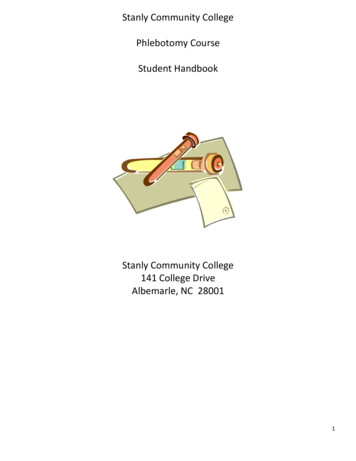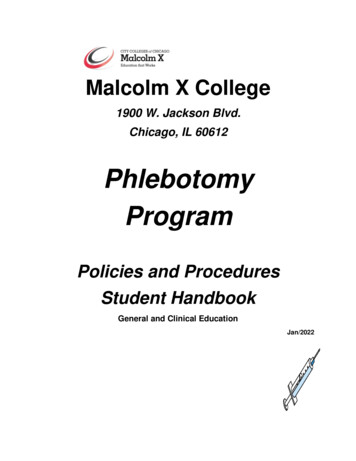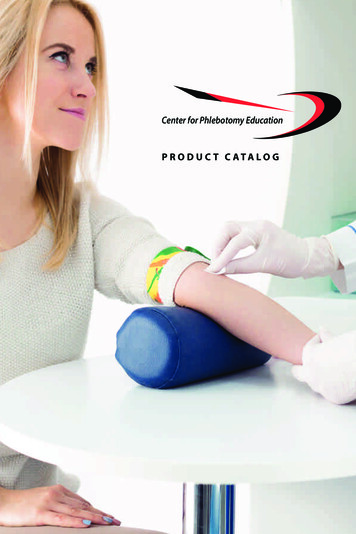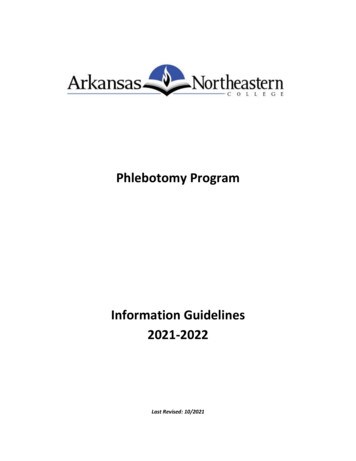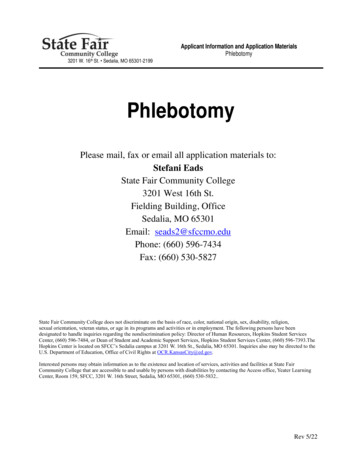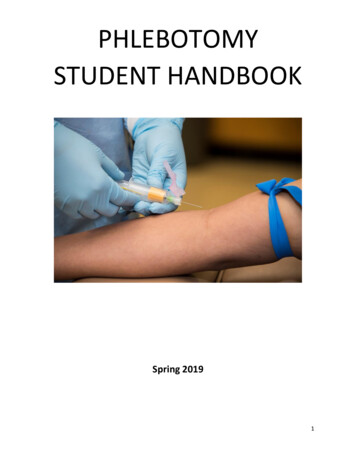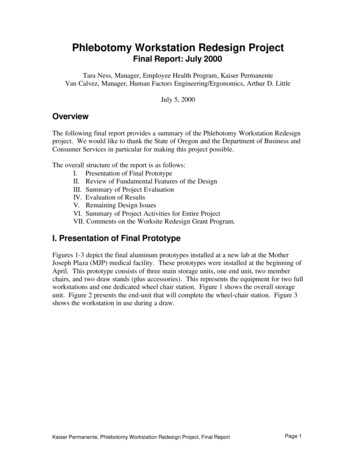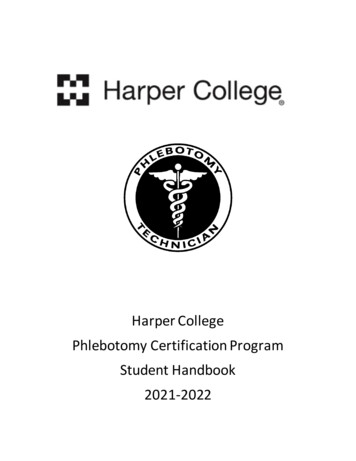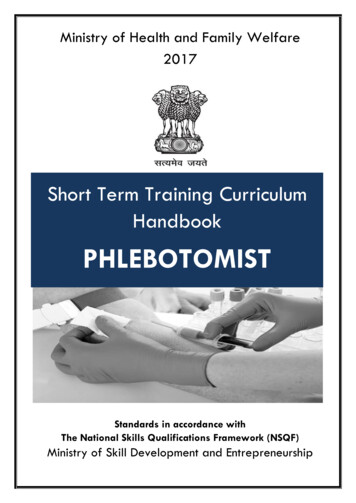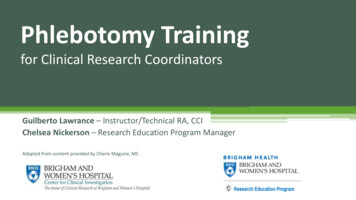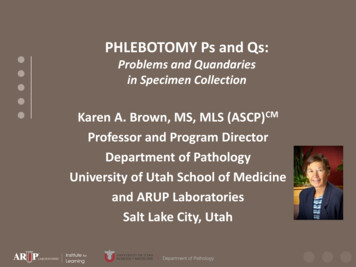
Transcription
PHLEBOTOMY Ps and Qs:Problems and Quandariesin Specimen CollectionKaren A. Brown, MS, MLS (ASCP)CMProfessor and Program DirectorDepartment of PathologyUniversity of Utah School of Medicineand ARUP LaboratoriesSalt Lake City, Utah
Phlebotomists face manychallenges . . . . . And endure all types ofremarks and comparisons
Phlebotomists Are ImportantMembers of the HealthcareTeam
Phlebotomists who are properly trainedand regularly participate in continuingeducation keep their knowledge updatedand technical skills sharp They work within the standard of patientcare at all times
Phlebotomy Challenges Dangerous conditions Problem patients and unusual patientsituations Risks associated with equipment andcollection site Communication issues Liabilities that impact patientinteractions
Course Objectives1. Discuss advantages, disadvantages, and challengesassociated with the collection of blood specimensfrom various anatomical sites and in special patientconditions and populations.2. Identify precautionary measures and actions thatpromote safe use of phlebotomy equipment.3. List barriers to effectively communicating withpatients.
Proper Patient IdentificationRemember . . . Only identifiers attached to the patient areacceptable Two identifiers are required Any discrepancies must be resolved beforecollecting specimens
Problems in PatientIdentification Patient has no ID band ID band not attached to patient ID band has incorrect information High-risk situations can be problematic Impatient healthcare providers Other?
By the Numbers Studies support the need for proper patientidentification Challenges persist A 2010 CAP Q-Tracks study determined an initial ID banderror rate of 7.4% Most common problem – bands were missing Estimates suggest that more than 160,000 adversepatient events occur each year in this country Thank goodness, 85% of these mistakes are caught But, what about the remaining 15%?
Quandaries in Vein Selection The venipuncture is an invasive procedure Infection is always a possibility Veins used for other purposes too
Veins in the ArmPreferredOptional
OtherOptional Veins in the HandVeins and Areas to Avoid
Venous ViewpointsIf accidentally puncture an artery note that arteries feel differentstop the venipuncture immediatelyremove needleapply pressure
Venous ViewpointsIf accidentally puncture a nerve stop the venipuncture immediatelyremove needlerepeat if necessaryfollow policies for documenting
Venous ViewpointsRemember that all patients are unique vein location varies from person to person don’t be afraid to feel for a vein feel both arms
Venous ViewpointsPotential for injury associated with all veins select vein that is most likely to be puncturedwithout injury to patient
The Median Cubital is Best
Phlebotomists EncounterRisks During Venipuncture
Risks Can be Minimized with SafeUse of Phlebotomy Equipment Gloves are requiredDiscard after entire procedure completedDon’t cut off tipDon’t wash
Safe Use of PhlebotomyEquipmentNeedles – a Little History . . . Needlestick Safety and Prevention Actsharps-injury prevention devicescommemorative conference heldrate of accidental needlesticks is downsafety needles widely usednon-compliance still a concern
Safe Use of PhlebotomyEquipmentWhy is rate of non-compliance with safetyneedles still high?
Safe Use of PhlebotomyEquipmentHow and when do risks occur when usingneedles in venipuncture procedures? removing needle from holdercontacting back end of needlebending/breaking needleimproper activation of safety devicerecapping needleimproper needle disposalother?
Safe Use of PhlebotomyEquipmentPrecautions Do not remove needles Do not reuse holders Never break, manipulate orrecap needles Use safety devices Immediately disposeof holder with needle Modify work practices Receive training
Safe Use of PhlebotomyEquipment
Problem Patients andUnusual Patient SituationsSometimes, situations warrant extraattention or intervention by thephlebotomist, pose additional risks to thephlebotomist or patient, or generally impactthe phlebotomy procedure
How Should These Patientsand Situations Be Handled? BurnsCasts or dressingsBreathing stopsConvulsionsMentally disturbedExcessive bleedingFaintingNausea/vomitingObesity (the bariatric patient)
How Should These Patientsand Situations Be Handled? TremorsArthritisUnconscious/unresponsive patientMastectomyAgitated/uncooperative patientIVs and VADsSpecial requestsCancer patients
Cancer Patients Veins often difficult to locateVeins are hard to accessHands and fingers may be coldTendency to bleedSwollen hands/arms
Special Patient PopulationsThe geriatric patient
Special ConsiderationsPhysiological changes occur in geriatric patients Skin loses elasticity, moisture and supportiveconnective tissue– thin skin allows veins to roll and bruising tooccur Muscle tone is lost and muscles may become smaller– angle of needle insertion needs to be more shallow Abnormal drops in temperature may occur– warm blood collection sites
Case StudyA young phlebotomist is assigned to collectblood samples from the psychiatric ward at thehospital where she works. The usual procedurebefore entering a patient’s room is to verifywith the nursing staff that all patients on thecollection list are stable enough to undergo aphlebotomy procedure. The youngphlebotomist is told that all patients are fine onthis particular day.
Case Study - ContinuedTherefore, she enters the room of a physicallylarge and tall woman. The woman seemsreceptive and willingly engages in appropriateidentification procedures. However, once thephlebotomist actually punctures the vein forblood collection, the patient unexpectedly jerksher arm away and pushes the youngphlebotomist so hard she staggers against awall.
Quiz QuestionWhat is the best course of action for thisphlebotomist?A. Approach the patient again – that sample must becollected.B. Activate the needle’s safety device, since theneedle is exposed and dangerous, then exit theroom.C. Make sure the patient has stopped bleeding, thenexit the room.D. Exit the room immediately.
Quiz Discussion
Communication Quandaries
Barriers Language– terms to avoid– accommodations may be needed Improper transmission– be aware of how voice is projected Disabilities– hearing impaired– visually impaired– use open-ended questions
Barriers Distracting noises– minimize as much as possible Age– use age appropriate vocabulary Tone of voice– be aware of inflection or pitch
Nonverbal CommunicationDisplay positive body language SmileUse eye contact to build trustFace patient to show respectRespect comfort zoneUse gentle, soothing touch when positioningpatient for blood collection
Nonverbal CommunicationNegative body language Nervous behaviors can make patient anxious Certain breathing patterns can convey boredomor reluctance What are some other actions that distract from aprofessional image?
Developing Good ListeningSkillsActive listening Paraphrase to understandFocus on content – what is the meaningMaintain eye contact to express interestMinimize external distractionsQuestions encourage and reassure the speakerFeedback allows for verification and clarificationPractice is needed
Case StudyA phlebotomy student is dispatched tocollect a prothrombin time (PT) from anoutpatient. The patient, though unfamiliarto the phlebotomist, states that she has PTsdrawn weekly and that a butterfly needlemust be used because she has small veins.
Case Study - ContinuedThe student palpates the vein, but chooses astandard sized, regular needle with a holder.She obtains the specimen without incident.Later that afternoon, the phlebotomist isnotified that the PT patient has filed acomplaint because the wrong type of needlewas used to collect the blood sample.
Quiz QuestionWhat communication skill did thephlebotomy student forget?A. Telling the patient what size needles she wasgoing to use.B. Using a soothing touch.C. Respecting the patient’s comfort zone.D. Listening to the patient.
Quiz Discussion
Summary/ConclusionWhat has been learned today?
Bibliography and References1.2.3.4.5.6.7.Center for Phlebotomy Education. Blood Collection FAQs. 2008.Clinical and Laboratory Standards Institute. Procedures for the Collection ofDiagnostic Blood Specimens by Venipuncture Approved Standard – SixthEdition. H3-A6, 2007.Clinical and Laboratory Standards Institute. Accuracy in Patient SampleIdentification; Approved Guideline. GP33-A, 2010.Garza, D., Becan-McBride, K. Phlebotomy Handbook, 8th Edition, Pearson,2010.Garza, D., Becan-McBride, K. Phlebotomy Simplified, Pearson, 2008.Phlebotomy Today. Volume 11, Issue 12. Center for Phlebotomy Education,December 2010.Stankovic, A. Advances in technology improving safety andefficiency in blood-sample draw. Medical Laboratory Observer, January2011.
Thank You!
2013 ARUP Laboratories
1. Center for Phlebotomy Education. Blood Collection FAQs. 2008. 2. Clinical and Laboratory Standards Institute. Procedures for the Collection of Diagnostic Blood Specimens by Venipuncture Approved Standard - Sixth Edition. H3-A6, 2007. 3. Clinical and Laboratory Standards Institute. Accuracy in Patient Sample Identification; Approved .
